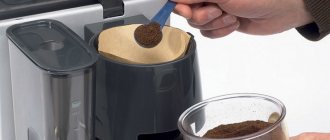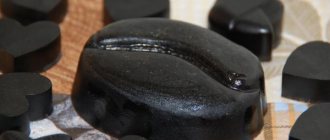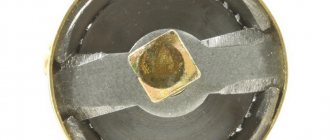A coffee grinder is an everyday household appliance designed to grind coffee beans. You can also grind cereals such as peas, lentils, corn, as well as dried herbs, breadcrumbs, medicinal herbs, roots, dried fruits, cereals, spices, and eggshells.
Modern household electrical appliances are more practical, quite durable, more powerful, convenient and easy to use. In modernized coffee grinders, the operating principle has remained virtually unchanged; only electronic control has been added. Essentially, a coffee grinder is an electrically driven mill; the grinders are millstones and rotary knives.
Electric coffee grinders often fail due to improper operation, due to the use of the device for other purposes, as well as when changing the modes recommended by the manufacturer. They must be protected from moisture penetration into the motor area.
It is not advisable to grind sugar in a coffee grinder, as well as oily grains - sunflower and walnut. It is not recommended to grind herbal seasonings, grind salt or pepper, or process large quantities. Salt promotes the rusting process. You should carefully read the instructions for the device, as it names products that you do not want to grind. If you do not violate simple operating rules, then each equipment will work reliably longer without repair.
But if the unit does break down, then unless the electric motor breaks down, you can fix the problem yourself. That is, you yourself can carry out minor, simple repairs to the coffee grinder.
Coffee grinder problems can be divided into two categories . Failure of the first category entails changes in the quality of work . Insufficient grinding of coffee beans occurs when the device is used for a long time without routine maintenance.
Knives and millstones need to be updated. If they are not updated in a timely manner, the degree of grinding will gradually decrease.
Problems of the second category represent damage to the electromechanical part of the coffee grinder .
Coffee grinders are relatively simple. The most common problem is that they can become clogged with coffee powder, which slows down the engine. Additionally, the electrical cord may short out, the thermostat may burn out, or the motor shaft may stop turning. Additionally, the switch may not function properly and the blade of the knives may become bent or dull.
Device
All coffee grinders are divided into two types according to the grinding method: burr grinders and rotary screw grinders. There are also differences between manual and electric, but the latter have firmly and thoroughly supplanted their mechanical counterparts.
What does a rotary electric coffee grinder consist of:
- frame,
- metal bowl,
- two-, less often four-blade propeller,
- transmitting rod,
- motor and wire
- lid.
This is how both expensive and cheap models are designed: “Bosch”, “Mikmah”. Soviet electric coffee grinders were also assembled in the same way.
To disassemble them, you need to follow these steps:
- Remove the cover.
- Detach the bottom. In Soviet devices it is fixed with screws using a Phillips screwdriver; in modern devices it is usually simply pryed off and removed.
- Tighten the locking screw in the center with a screwdriver.
- Carefully unscrew the rotor screw with your hand or a pair of narrow-nose pliers (in the same direction in which it grinds the coffee).
- Remove the screw and bowl.
- Dismantle the main body.
Important Before disassembling the coffee grinder, it must be disconnected from the power supply.
Burr coffee grinders are generally disassembled according to the same principle.
- Use a screwdriver to pry it off and remove all the turntables.
- Use the same method to disconnect the bottom (it is advisable to get on the 4 stopper teeth).
- Unscrew the 4 screws around the perimeter and remove the top part.
- Remove the coffee tank (cup).
- Remove the remaining grains with a spoon and then with a vacuum cleaner.
- Remove the disc that regulates the grinding (rotating clockwise).
- Remove the upper stationary blade of the millstone.
- For further cleaning, remove the shock-absorbing springs.
Depending on the model and brand, the algorithm will be slightly different; Miss Clean magazine recommends following the instructions for the specific model.
Repair of coffee grinders in service centers
Coffee grinders can also be repaired by manufacturers and parts suppliers. Repairs at manufacturer service centers are expensive. For example, repairs of various Baratza coffee grinder models from the manufacturer cost from $40 to $90, and replacement of millstones costs from $29 to $60.
To repair, you need to fill out a form on the manufacturer’s website and send the coffee grinder via mail.
Service centers in the Russian Federation do not indicate the cost of repairs on their websites. The indicated delivery price is 180 rubles. They offer free diagnostics, a guarantee for work performed for up to 1.5 years, adherence to established repair deadlines, a technician, a system of discounts, courier delivery, repairs in an hour, certified technicians, as well as their own warehouse of spare parts. They promise to announce the price before repairs.
In Nur-Sultan you can find ten service centers for coffee grinder repair. They also do not indicate the cost of the service.
Post Views: 17,629
How to grind coffee and use the unit correctly
True gourmets of the drink claim that when preparing coffee, the most important thing is its correct grinding. There is a whole science that describes all the nuances of this seemingly simple operation. Due to the fact that the popularity of drinking coffee has recently become enormous, specialized professionals in this field of cooking have emerged. Sometimes their opinions differ. However, when it comes to grinding coffee beans, experts are inclined to believe that proper grinding occurs either in a manual coffee grinder or in an electric one equipped with millstones. A rotary coffee grinder grinds less evenly, and the resulting final product contains particles of different sizes. In addition, at high speeds of the knives, the coffee burns, which leads to a change in its taste.
The grinding time should not be long. As well as the time from grinding to brewing the drink. The longer the coffee is ground, the more essential oils evaporate. Therefore, the optimal grinding time is considered to be no more than 20 seconds.
Over time, the coffee grinder began to be used not only for coffee. You can crush nuts, eggshells, cereals, salt, sugar and other bulk food products in it. For example, at home using a coffee grinder you can make powdered sugar from ordinary loose sugar.
To obtain powdered sugar, you need to load a certain amount of granulated sugar into the coffee grinder container and turn on the engine for a few minutes. To obtain high-quality powder, you need to bring the consistency of the powder to the state of fine dust. For a fragrant smell, add a little vanillin or vanilla sugar.
In culinary practice, powder mixed with fragrant nutmeg is also used. To do this, first grind a well-dried nut, and then add sugar to it and grind it all together.
It is not recommended to grind products that have a persistent odor in the same coffee grinder. For example, you should not crush pepper in it, the persistent smell of which can then be transferred to the coffee drink.
About the brand
The Bork company has German roots, but the main office is in Moscow. The products of this brand were originally developed for the Russian premium buyer: that is why the brand is so loved and respected. Technology for a comfortable and beautiful life is the company’s mission. Sold through official distributors (well-known household appliance chains), as well as through our own network of mono-brand boutiques.
Bork's products include basically everything to create comfort: home climate control equipment, air purifiers. But the most important thing is, of course, the kitchen! From this manufacturer you can find a huge selection of devices for a modern and high-status kitchen. Powerful steel and glass kettles (there is even a gold-plated model), coffee makers and coffee machines, ultra-modern steamers, slicers, meat grinders and waffle irons and, of course, a wide range of blenders.
Power range - from 170 W to 2200 W. The price depends on power, capacity (if we are talking about a stationary model), materials (some models have a durable all-metal body, and some are supplemented with plastic), the use of innovative or patented technologies. But you should understand that even the cheapest device from the Bork line will cost an order of magnitude higher than blenders from other popular brands.
Causes of breakdowns and prevention
The simplest and most common cause of malfunction of any coffee grinder is clogging. Powder and external debris often get under the propeller and get stuck there; in cheap models, they accumulate inside the housing, threatening the motor with overheating.
Sometimes the device refuses to work not because of a breakdown, but because of sensitive sensors. Modern rotary coffee grinders are equipped with fuses that prevent the motor from starting if the lid is not completely closed. If coffee powder gets into the grooves for the spikes, the sensors detect insufficient tightness. Such a gap is often not noticeable to the eye.
If you use the device for purposes other than its intended purpose, for example, grinding salt or pepper, there is a high probability of jamming the rotary screw. Salt also causes rust, which is not at all desirable. To wash the bushing and screw, it is better to use alcohol, which evaporates quickly and does not increase the humidity inside the device.
Burr coffee grinders are more likely to suffer from electronic malfunctions than from clogging. In particular, the capacitor fails - it can be completely replaced if you have a soldering iron and solder in the house; it is not difficult to find an analogue in any radio parts store.
Analysis of the electrical fault of the Zauber Z-490 coffee grinder is in the video below.
There are also complaints on forums that the rotation screw does not unscrew. If it is clogged at the axle or rusted, it is enough to dab it with alcohol and leave it for a while. If the plastic base in which the blades are held is flattened or otherwise deformed, it will either have to be drilled out or a screw/nail fused into it and then removed.
Prevention
To avoid problems, just follow a few simple rules:
- Store the device in a dry place, do not wash, but only sweep or wipe.
- Clean the device from time to time (small ones with a brush or brush, large ones with a vacuum cleaner and a brush), this is vital for millstone models; semi-professional devices need general cleaning every 2000 servings.
- Do not exceed the permissible load, this applies to both the volume of loaded grains and the duration of one grinding session. The instructions for most rotary coffee grinders indicate a limit of 2-5 seconds, after which the device needs to “rest” for the same amount of time.
- Use the device only for its intended purpose.
Modern coffee grinders are often more powerful than Soviet ones, but are inferior to them in terms of durability, especially when it comes to rotary ones. Millstones are designed for more frequent use, but, as practice shows, they are often let down by electronics. Today there are many service centers ready to service the coffee grinder, but if you follow simple rules, the unit will last a long time without repair.
When is the help of a specialist needed?
A number of coffee grinders have electronic controllers that fail due to overloads or increased voltage in the power circuit. The fault can be determined and the unit repaired only in a workshop. To disassemble housings and check electric motors, special equipment may be required, which is available at an authorized service center. If there are no such devices at home, and the owner has no experience in servicing household appliances, then it is more advisable to hand over the coffee grinder to a specialist.
How to fix problems of the second category
Problems of the second category represent damage to the electromechanical part of the coffee grinder.
| Types of coffee grinder malfunctions | Remedies |
| Broken power cord or poor contacts in the socket. | Using a voltage indicator, find the location of the power failure. The current is restored, the contacts are cleaned, and the junction is isolated. |
| Damage to the switch and jamming of the engine blocking drive. | The faulty switch is removed from the device body and a new one is installed in its place. The engine blocking drive with the cover open is thoroughly cleaned and its free movement is checked. |
| Interruptions in engine operation. Short-term changes in the speed of rotation of the working shaft. Stops when the start button is on. | The brushes may wear out and need to be replaced. Engine manifold contamination. The collector is cleaned and wiped with a cloth soaked in cologne or alcohol. |
More complex repairs associated with rewinding the windings of electric motor coils are, as a rule, not justified and require a lot of time. It's easier to replace the entire motor.
A common and characteristic failure of coffee grinders is the failure of bearings. Although they are protected by special rubber boots, during grinding fine dust still penetrates onto their working surface. This leads to jamming of the electric motor armature. The problem is easily solved - the bearings are cleaned and lubricated with some mineral oil. After this, they can last for a very long time.
The choice of coffee grinder depends on the purpose of its purchase and the volume of planned processing of coffee beans. Coffee grinders from such world-famous companies as Krups, Bosch, Scarlett, Delonghi have proven themselves well. Professional units are capable of passing large quantities of coffee through themselves, while household ones are designed for preparing a coffee drink within the family circle. They also differ in weight, power and other performance indicators. When choosing, you should also take into account the dimensions of the machine, which in some models reach 2.4 m.
Reviews
I have been using a Bork coffee grinder for several months now. I bought a powerful, expensive j800 model because my wife and I are big fans of freshly brewed coffee. We are happy with the purchase; during the entire period of operation the machine never failed. It works automatically, just press a button and that’s it. Loads almost half a kilogram of beans, convenient electronic control, 25 grinding levels, easy to clean and the bowl is large enough for ground coffee. We made it for a carob coffee maker and for a Turkish coffee maker, everything is just perfect. For the device - an A plus.
Great coffee grinder! I bought it not long ago and I like it so far. What’s attractive is that you don’t have to hold the start button for long; you just need to set the desired grind level and press the button. Everything is automatic, the grinding is uniform, the resulting coffee is great, I don’t see any shortcomings yet. Let's see how it will work further.
I bought my first coffee grinder from this manufacturer about 6 years ago. All this time it worked practically without problems. Although I didn't use it that often. I only changed the knives 2 times. Now I decided to buy a new model. I wanted to buy the most powerful one, but it turns out to be a bit expensive. Therefore, I settled on a cheaper option. I hope it won't let you down.
I am a big coffee lover and try to drink only good varieties. And in order not to spoil the quality grains, I use a good grinding machine. Bork is perfect for this purpose; he does everything efficiently and quickly.
Colleagues gave me a Bork coffee grinder for my birthday. Beautiful design, stylish and strict. Fits perfectly into the kitchen interior. There are no complaints about the grinding, it is suitable for any coffee maker, it works quietly. I am delighted with such a cool gift!
Source
How to disassemble
Coffee grinder devices have a simple disassembly scheme that anyone can handle. The main thing is to study the sequence of the algorithm.
All coffee grinders come in two types:
- with a knife device;
- burr mills.
Models with a millstone device have a separate mechanism for disassembling the grinding mechanism. Moreover, each model may have a different parsing process. But they have common features:
- It is worth paying attention to the fact that the devices have conical knives attached to the drive shaft with 3-4 bolts. They can be easily unscrewed with a screwdriver;
- When reassembling, it is important to ensure that the bolt heads fit exactly into the seats;
- If the bolts are loosely tightened and not fully tightened, this may subsequently lead to failure of the device. Also, small metal particles will constantly be detected in the grinding, this may be due to the fact that the protruding parts of the fastening elements will be in the area of movement of the grinding device;
- Disassembling the casing of coffee grinders is quite simple. To do this, several screws are unscrewed on the lower plane, at the bottom of the device. Access to the mounting components may be open or may be blocked by the legs of the device;
- a separate group of grinders may have latches. To do this, you should use special probes or screwdrivers, with which you can bend the latches.
Engine
An important part of the device is the motor. In order to dismantle and inspect this element, it is recommended to remove the knives. They can be removed using several methods:
- When the knife moves clockwise, a left-hand thread is usually applied to the joint surface. To remove, a screwdriver is placed in a special slot and turned clockwise;
- When the knife moves counterclockwise, the connection has a right-hand thread. Accordingly, the screwdriver probe is also placed in the slot and turned counterclockwise.
Engine and knife
Over a certain period of time, the fastening part becomes clogged with particles from grinding. It can also be negatively affected by oxides. To remove all this, you should use special lubricants; these products can also make the process of unscrewing the knife blocks much easier.
If the clamping nut has a conical thread and is made of bronze metal, then it is worth warming up the area with the connection a little. You can use a soldering iron to warm it up.
The subsequent process may depend on the grinder model. In any case, disassembling the device must be careful and accurate, during it it is necessary to monitor the limiters, all elements must be correctly removed from the grooves.
After the knives are removed, you only need to perform a few steps:
- The fixing nut from the plastic base is unscrewed. It provides fastening of the grinding glass;
- When unscrewing the fastener, you should keep an eye on the felt base gasket. Under no circumstances should it be lost;
- then the axle washer, which is made of a metal base, is removed;
- then the blocker plate is removed. To do this, it is carefully pressed downwards and removed from the area with restrictive grooves.
Typically, for most models of coffee grinders, the disassembly process ends with removing the dirt washers and dismantling the power cable and switch. Often, during the process of disassembling the device, it can be revealed that the breakdown occurred precisely because of the washer, for example, it burst or completely collapsed.
Repairing a coffee grinder is not difficult, the main thing is to properly disassemble the device. During disassembly, the sequence must be followed, which will also need to be followed during the process of putting the device back together.
If during disassembly it is revealed that some element is broken or destroyed, then it is better to find out the details of the component parts for the coffee grinder model; this can be found on the Internet or in the instructions. Then you can go to a store or market to purchase the part exactly by number and series.
The lineup
The most popular among buyers are coffee grinders that balance between quality and price.
Bork j500
This grinder, which has a rotary system, is the smallest in the entire line and can be considered a simple grinder, capable of grinding any spices, as well as sugar and nuts, in addition to coffee. Main parameters:
- replaceable steel knives;
- bowl with a capacity of 75 g;
- power 200 W.
The price of the Bork j500 coffee grinder is from 4 thousand rubles, which is somewhat more expensive than similar offers from many other manufacturers.
Bork j500
Bork j700
This rotary grinding system kitchen appliance has:
- steel knives;
- 5 grinding levels;
- power 250-270 W;
- grain container with a capacity of 75 g;
- removable container designed for finished powder.
The unit has a 12-month warranty and weighs just over a kilogram. The height of the coffee grinder is 22 cm, the depth is 14 cm, the width is 14 cm, it fits perfectly on a built-in niche or shelf. The price starts from 5500 rub. Spare parts for the Bork j700 coffee grinder are sold in any region of our country.
Bork j700
Bork j701
This kitchen unit has a millstone grinding system and has the following characteristics:
- millstones made of stainless steel;
- 5 grinding levels, from fine to coarse;
- removable container for ground coffee;
- power - 165-170 W;
- stainless steel housing.
The weight of the Bork j701 coffee grinder is 2 kg, height is 28 cm, depth is 12 cm, width is 17 cm, power cord length is 1 m. The warranty on the kitchen appliance is 12 months. The cost of a coffee grinder is from 9900 rubles. It is easy to disassemble the coffee grinder to replace the blades yourself. Before use, as well as routine repairs of the unit, you should carefully study the instructions.
BORK J701
Bork j800
This model is considered top-end, among the entire line it is the most expensive - 20 thousand rubles. This cost for this kitchen appliance can be considered a kind of record, since among household coffee grinders it is difficult to find equivalent ones in price. The Bork j800 coffee grinder with a burr grinding method has the following differences:
- steel body;
- conical millstones made of stainless steel;
- electronic control;
- capacity 450 g;
- power 165 W;
- container for ground coffee 120 g;
- adjustment of the grinding process, consisting of 25 degrees.
Bork J800
How to quickly and without damaging the device disassemble the Soviet ZMM coffee grinder
Soviet manufacturers of household appliances for the kitchen tried to make them as functional and easy to use as possible. The ZMM coffee grinder, even after many years of operation, performs its functions perfectly, but if problems arise, the device can be disassembled. This should be done in the following sequence:
- Remove the knife using a screwdriver - insert it into the slot on the bottom of the device and unscrew the part in a smooth counterclockwise motion.
- Unscrew the plastic nut by turning the pliers counterclockwise 90 degrees.
- Remove the glass and plastic cup holder.
- With a gentle movement, remove the metal washer from the axis holding it.
- By simultaneously pressing the fixing plate and the lock, the parts are also turned counterclockwise and the platinum is removed (after it comes out of the grooves).
- Next, you need to remove the power button after the locking spring is bent.
- Remove the mud washer from the axle.
- — Release the wire after performing the following manipulations: bend the ring at the bottom of the ZMM coffee grinder body, unscrew the two screws securing the electrical wire.
- Remove the device motor.
Coffee grinder ZMM
The technology for disassembling the ZMM coffee grinder is somewhat reminiscent of opening the Mikma Ekma IP-30. Some models of coffee grinders are not recommended to be disassembled at home at all. One of these models is considered to be Vitek 1540. The only thing that can be done with this device is to disconnect it from the power supply and thoroughly clean the inner surface and knives. The manufacturer recommends doing everything else at a service center or in the office of a qualified technician.
Disassembling the Russian coffee grinder Mikma IP 30
Most uninformed buyers fail to disassemble the IP-30 coffee grinder from a Moscow company the first time.
You can correctly disassemble the Ekma coffee grinder in the following sequence:
- Remove the plastic cover.
- Hold the impact mechanism splitter with one hand, and with the other hand take a screwdriver and smoothly unscrew the screw on the bottom of the coffee grinder.
- Remove the divider.
- Use pliers to turn the plastic holder (from right to left and vice versa) located inside the metal bowl.
- Remove the holder from the bowl.
- Remove the protective clip and bowl from the device body.
- Turn the metal bar from right to left and separate it from the grooves of the coffee grinder body.
- Pull out the contact from the base of the power button, carefully move it to the side, and remove the electric motor from the housing.
- Remove the oil seal from the engine shaft and the rubber shock absorbers from its shields.
- — Inside the case, remove the spring that controls the operation of the turning button and remove the button.
- Release the power cord by first unscrewing the screws securing the bar.
The technology for disassembling the Mikma Ekmu IP-30 coffee grinder is quite complex, so at home it is better to do it using the video example.
Manufacturers of household appliances use a variety of technologies. Most devices are characterized by high strength and tight fastening of parts. For example, it is precisely because of the manufacturing technology that it is difficult to disassemble a Bosch coffee grinder (model Bosch MKM-6000), while its analogue, the Belarusian model Vitek 1540, can be opened in a few minutes.
Bosch
Perhaps the easiest way to disassemble of all coffee grinder samples is the Bosch mkm-6003 model. The algorithm of actions is as follows: to remove the knife, you just need to unscrew it clockwise, and you can pull out the motor by loosening the power cord and pulling the motor towards you. That's all.
One person can no longer handle the Bosch mkm-6000 model. Need outside help or access to a good vice. First, you need to fix the unit in the hands of an assistant or clamp it in clamps so that it is strictly horizontal. Next, use a screwdriver or feeler gauge to pry up the bottom in the area where the power cord is attached. Then, having driven the first screwdriver to a depth of one centimeter, the second one needs to feel for the latches and carefully separate them. In this case, you should hold the bottom so that the motor, which is pressed against it, does not fall out. The apparent simplicity of the process should not be misleading, since the main difficulty lies precisely in the latches, the separation of which requires great skill and patience.
Coffee grinders from other brands
Basically, all coffee grinders are easy to disassemble. Usually it is enough to unscrew 2-3 screws from the bottom of the case. Sometimes you have to tinker with the latches. But there are also secrets, like the Bork j700 model: to get to the printed circuit board, you need to remove the grind switch knob, which is secured with a washer instead of a nut (it is this that needs to be unscrewed). The original opening is also typical for the Elmaz coffee grinder. The nuance is that you first need to turn the bottom with your palm, and then remove it from the hooks in the body.
Advice! Special mention can be made for the Vitek 1540 model. It is not recommended to disassemble it at home. This can only be done by qualified service technicians.
"Bosch MKM-6000"
It's not so easy with this model. Masters believe that they cannot cope without help. Because you need to hold the device in your hands or in a large vice. To do this, it is placed in a horizontal position and without movement. Where the cord is fixed, you need to pry the bottom with something - use a screwdriver, a probe or just a metal stick. Having made a small gap, you will have to feel for the fastenings - latches. They are disconnected, but carefully, because the motor is located at the bottom. If you let him go, everything will fall out.
When the latches are disconnected, there will be no further difficulties. You should not lift the bottom with sudden movements, otherwise the Bosch coffee grinder will break. It is not always possible to disassemble it the first time.
What parts can fail?
The features of blender repair directly depend on which component has failed. Some parts can be repaired, while others must be replaced.
Filters
Modern types of kitchen blenders have a filter in the lid. Additionally, you can use a mesh filter by installing it in the bowl.
Diode bridge
Budget blender models have one rotation speed, and the electric motor in them is powered directly through a diode bridge. A faulty part causes the engine to slow down or not start. To use the device in normal mode, you will need to perform diagnostics and, if necessary, repair or replace the diode bridge.
Transformer
The role of the transformer in a kitchen blender is to control the voltage level that is transmitted to the electric motor.
Generator
The generator is one of the key internal components and works in conjunction with other mechanisms, including the engine. It is possible to detect a generator malfunction only by disassembling and diagnosing the equipment.
Key transistor
The key operating mode of the transistor is one of the simplest and most common. Most of the time, the blender transistor is in two states: cutoff and saturation. A transistor malfunction results in the device not responding after switching on.
Rectifier output diodes
To check the functionality of the rectifier output diodes, a standard testing procedure is carried out. In many types of blenders, the motor is connected via a diode, so the ability to operate the device depends on the correct operation of the component.
Varicaps
Varicaps are semiconductor diodes. They change the capacitance indicator in proportion to the magnitude of the applied reverse voltage.
Circuit breakers
If you use the blender continuously, the fuse may burn out. In this case, it is not allowed to use the device until repair or replacement is carried out. Otherwise, you can provoke new breakdowns.
Food Processor Complementary Ingredients
The blender, which is an integral part of the combine, is in many ways similar to the stationary model. The device is built into the food processor and has many functions. If repairs are necessary, it may be necessary to partially disassemble the combine.
Replacing the knife
If the knife is significantly damaged, it must be replaced. For most blender models, purchasing a blade is easy because they are sold as separate replacement parts.
How to pull it out
After purchasing a new knife, you must first remove the old one and replace it. The process involves performing the following actions:
- When starting to disassemble the device, first unplug the blender from the outlet and remove the bowl.
- To avoid getting hurt by a sharp blade, take a clean towel and unscrew the knife from the motor spindle. Since the threaded connection is not standard, the knife must be unscrewed by rotating to the left.
- If the knife is fixed in the bowl with nuts, you need to use wrenches or pliers to remove the part.
How to disassemble the bowl
There are models of devices in which to install a new knife you will need to first disassemble the bowl. As a rule, it is enough to remove it from the central mount
It is important not to forget to replace the oil seal with a new one.
If the bowl is not removable
In cases where the design features of the blender do not allow disassembling the bowl, the only way to solve the problem is to replace the bowl along with the knife. You need to choose a bowl that is the right size and fix it in the correct position.
Speed controller
On many blenders, the speed controller often breaks down. Due to incorrect operation, the speed may change during operation or be greatly reduced.
Part removal
In stationary varieties, there is often a problem with checking the switch due to the presence of a switch lock without a bowl. To remove the regulator from the case, you will need to unsolder it and check the condition of the internal components.
Calling
Testing the speed controller helps to find an open circuit or short circuit, which facilitates effective diagnosis and elimination of the problem. For testing, use a special device, a multimeter. It is allowed to ring only de-energized circuits to avoid injury or damage to the equipment. The procedure is performed according to the following instructions:
- Fix the probes in the connectors of the multimeter.
- Switch on the dialing mode on the device, after which the display should display one.
- Check the correct functioning of the multimeter by connecting the probe contacts. If the device is working properly, it will emit a beep.
- The multimeter probes are applied to the contacts on the speed controller. If there are no faults, the buzzer will sound and a value close to zero will appear on the screen.











